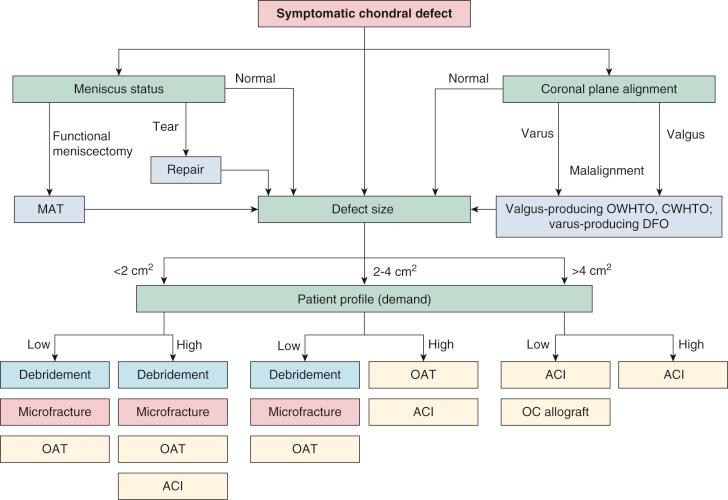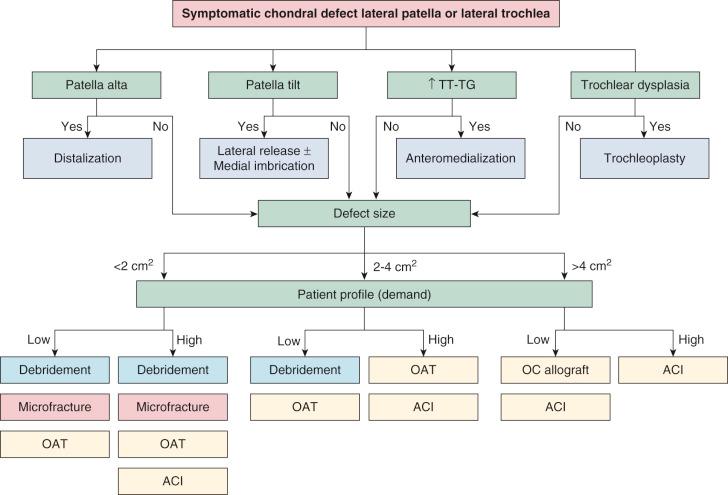Physical Address
304 North Cardinal St.
Dorchester Center, MA 02124
Symptomatic full-thickness chondral defect
Symptoms such as direct tenderness at lesion, activity-related weight-bearing pain, effusion, and response to injection
Treat concomitant pathology (meniscus, alignment, ligament)
Patient selection and addressing expectations are critical
Asymptomatic
Patients unwilling or unable to comply with postoperative rehabilitation
Uncorrected concomitant pathology (meniscus, alignment, ligament)
Osteoarthritis
Management of symptomatic focal chondral and osteochondral defects in the knee is complex and multifactorial. The most salient principle in evaluation of the clinical presentation of patients with focal chondral defects of the knee should focus on “treating the patient” and not the defect. This means avoiding linear reasoning in the presence of a known defect that lacks an inexorable nexus with a patient's clinical presentation. The existence of a lesion on magnetic resonance imaging (MRI) or arthroscopic image should not automatically indicate surgery. It is well known that chondral defects are highly prevalent in both symptomatic and asymptomatic patients ( Table 31-1 ). The incompletely understood natural history of articular cartilage lesions and the predictability of their surgical outcome mandate ensuring that the defect is clinically relevant and a competent source of the patient's symptoms.
| Subject Population | Prevalence (%) |
|---|---|
| All ages: all defect locations, sizes, depths | 60-63 |
| All ages: all defect locations, sizes, only full-thickness defects | 16 |
| All defect locations: age <40 yr, only full-thickness defects | 5-7 |
| Concomitant anterior cruciate ligament tear | 16-46 |
| All locations: amateur and professional athletes, only full-thickness defects | 36 |
| All locations: asymptomatic professional basketball players, runners | 59-77 |
Ascribing symptoms to a lesion warrants determination of the exact location of the defect that is tender on exam, if this location of pain is exacerbated by weight bearing, if biologic activity is present via detection of an effusion, and if there is a reduction of pain with intraarticular injection. Articular cartilage is an aneural tissue. Thus, the presence of a defect does not necessarily produce pain. However, patients with full-thickness lesions may demonstrate clinically important limitations in pain, function, sports and recreation, and quality of life as measured by Knee injury and Osteoarthritis Outcome Score (KOOS) subscores. These limitations are not significantly different than those experienced by subjects with arthritis enrolled for osteotomy or arthroplasty and may be worse than those with anterior cruciate ligament (ACL) deficiency. The exact mechanism accounting for pain caused by pathology in an aneural tissue is not completely understood. Stimulation of periarteriolar nociceptive fibers in the subchondral bone is one theory. In addition, the intraarticular biologic inflammatory milieu likely plays a large role with reduced anabolic factors and increased catabolic and nociceptive factors. This leads to synovitis, effusion, capsular distention, and pain.
Once the determination that a defect is symptomatic has been made, conservative treatment options may commence. These include, but are not limited to, rest, activity modification (typically reduction in load, including reductions in body mass index [BMI]), oral antiinflammatory medications, glucosamine, chondroitin, methylsulfonylmethane, injection therapies (steroid [methylprednisolone, triamcinolone, betamethasone], nonsteroid [ketorolac], hyaluronate viscosupplementation, platelet-rich plasma [PRP]), and physical therapy with modalities. Despite the therapeutic effect of injections, the diagnostic effect of added local anesthetic may provide more clinically useful information in determining the severity of symptomatology and may hint at the responsiveness to subsequent treatment.
In the situation of failed conservative treatment, surgical decision making is predicated on the patient's informed consent. This includes recognition of and addressing the patient's preoperative expectations. Complete disclosure of the surgical algorithm ( Figs. 31-1 and 31-2 ) and each technique's advantages, disadvantages, risks, benefits, alternatives, expected outcomes, and postoperative rehabilitation is warranted. The algorithm for selection of the optimal technique is based on multiple patient factors (age, gender, activity level, BMI, symptom duration), limb- and knee-related factors (meniscus, cruciate and collateral ligaments, alignment), and defect-specific factors (location, size, depth, subchondral bone). There are three general categories for surgical procedures designed to address articular cartilage pathology in the knee: (1) palliative (chondroplasty, debridement, lavage, meniscectomy), (2) repair (microfracture, drilling, abrasion, augmented scaffold-supported marrow-stimulation techniques), and (3) restoration (osteochondral autograft, osteochondral allograft, autologous chondrocyte implantation [ACI], and other chondrocyte- and mesenchymal stem cell-based therapies).


In addition to the treatment of the defect, concomitant limb and knee pathology must be addressed in either simultaneously or staged fashion. These entities include meniscal preservation (repair or transplantation), alignment correction (varus or valgus malalignment treatment with proximal tibial or distal femoral unloading osteotomies, respectively, and patellofemoral malalignment treatment with anteromedialization Fulkerson-type tibial tubercle osteotomy), and knee ligament reconstruction. The time commitment, intensity, and duration of the postoperative rehabilitation must not be overlooked or underestimated. The time to return to impact activities and return to sport must be discussed. Furthermore, in the setting of competitive athletes, the following factors play a significant role: timing of surgery (in or off season, stage of career); level of sport (high school, collegiate, elite amateur, professional); scholarship, contract, or bonus status; and opinions of stakeholders in the athlete's care (owners, managers, coaches, trainers, agents, teammates, family, friends, spouses). Given the prevalence with which chondral pathology is identified in professional athletes' knees, the length of time required to rehabilitate following surgery, and the subsequent implications (time lost to team, financial), it is critical to carefully and appropriately select the correct surgical technique in this patient population. As a general consideration, if there is an extraarticular treatment (e.g., osteotomy) that can predictably relieve or improve an athlete's symptoms, strong consideration for delaying an intraarticular procedure (e.g., articular cartilage transplantation) until his or her career is over is a reasonable option.
There are several groups of subjects that are not candidates for articular cartilage restorative techniques in the knee. There is currently no role for prophylactic cartilage restoration in asymptomatic subjects. However, two exceptions to this contraindication exist: large surface area osteochondritis dissecans lesions and post-lateral meniscectomy in active females with valgus lower extremity alignment. In general, low-level symptoms should drive most early decision making rather than the theoretical risk of progression. There are no clear data showing that neglect leads to inexorable progression or, conversely, that treatment may halt or attenuate progression. Patients with osteoarthritis have an irreversible process illustrated via diffuse degenerative changes of subchondral bone sclerosis, subchondral cyst formation, osteophytes, and joint space narrowing. Patients not willing or unable to comply with the postoperative guidelines and rehabilitation protocols are contraindicated. Other contraindications include uncorrected comorbidities (meniscal deficiency, malalignment, ligamentous insufficiency), malignancy, and infection. Relative contraindications include elevated BMI, tobacco use, and inflammatory arthritides such as rheumatoid arthritis, psoriatic arthritis, gout, and pseudogout.
Become a Clinical Tree membership for Full access and enjoy Unlimited articles
If you are a member. Log in here